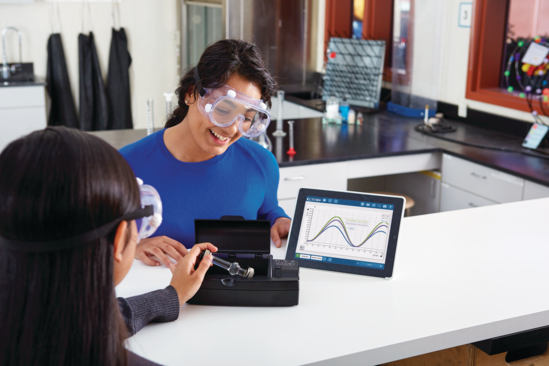



PASCO's Wireless Polarimeter measures the optical rotation of chiral compounds and features Bluetooth connectivity.
- 1x Polarimetry Sample Cell Replacement
See the Buying Guide for this item's required, recommended, and additional accessories.
Product Summary
The Wireless Polarimeter has both Bluetooth® and USB connectivity, making it possible to analyze chiral compounds with your iPad®, Chromebook™, Android tablet, or computer. It is ideal for introductory experiments in Organic and Biochemistry, where chiral compounds are of special interest.
PASCO's Wireless Polarimeter passes plane polarized light through a vertical sample, which contains a chiral compound, followed by an analyzer and detector. The optical rotation is determined by finding the angle between the starting position and the location where the optimum light level transmits through the cross polarizer. Students can use the rotation data to calculate the concentration of a chiral sample, while the specific rotation (amount turned per g/ml dissolved) is an intrinsic property that can be used to differentiate molecules or determine racemic mixtures.
How It Works
The speed of light around chiral atom centers is anisotropic (slower for light vibrating in one dimension than that at 90 degrees from this). This causes a component of the oscillation, say the horizontal portion, to slow down causing the composite plane of oscillation to rotate as it passes through the solution. A second polarizing film is rotated until a maximum amount of light makes it through to the detector. The angle from initial orientation to where it was deflected is considered the optical rotation. A single color of light is used because much like red light refracts less than violet through a prism, in an optically active solution, red is rotated less than orange, less than green, then blue and violet. This can be observed in the polarizer demo set (OS-9477A) as a solution of Karo syrup changes color between the two larger polarizers from red to violet as the cross polarizer is rotated to let the next color through the appropriately aligned color.
What's Included
Product Specifications
| LED light source | 589 nm |
| Optical Rotation Accuracy | ±0.09º |
| Cell Length (horizontal) | 101.3mm ± 0.8mm |
| Cell volume | 12 ml |
| Connectivity | USB and Bluetooth 5.2 |
| Logging | No |
| Battery Type | Rechargeable LiPo |
Battery & Logging
| Battery connected (Data collection mode) | > 11 hr |
| Battery Type | LiPo |
| Remote logging | Not supported |
| Stored Data Points Memory (Logging) | Not supported |
1 Minimum # of data points with all measurements enabled, actual results depend on enabled measurements.
2 Continuous use in a connected state until battery failure, actual results will depend on sample rate, active measurements, and battery condition.
3 Logging until battery failure, actual results will depend on sample rate, active measurements, and battery condition.
* Normal classroom use is the sensor in active use for 20min/lab for 120 lab periods/yr.
Data Collection Software
This product requires PASCO software for data collection and analysis. We recommend the following option(s). For more information on which is right for your classroom, see our Software Comparison: SPARKvue vs. Capstone »
Connectivity Options
This product can connect directly to your computer or device with the following technologies. No Interface required. See the following guide for details regarding device compatibility: Wireless Bluetooth Product Compatibility »
Dedicated Datalogging with SPARK LXi2
Consider an all-in-one, touchscreen data collection, graphing, and analysis tool for students. Designed for use with wired and wireless sensors, the SPARK LXi2 Datalogger simultaneously accommodates up to five wireless sensors and includes two ports for blue PASPORT sensors. It features an interactive, icon-based user interface within a shock-absorbing case and arrives packaged with SPARKvue, MatchGraph!, and Spectrometry software for interactive data collection and analysis. It can additionally connect via Bluetooth to the following interfaces: AirLink, SPARKlink Air, and 550 Universal Interface.
Buying Guide
| Replacement Parts | P/N | Price |
|---|---|---|
| Micro USB Cable | PS-3584 | -- |
Experiment Library
Perform the following experiments and more with the Wireless Polarimeter.
Visit PASCO's Experiment Library to view more activities.
Equilibrium of Sugar Mutarotation
Students use a polarimeter to determine the α- and β-anomer concentrations of a D-glucose solution at equilibrium, and calculate the equilibrium constant.
Kinetics of Sugar Rotation
Students use a polarimeter determine reaction order and rate constant of an acid-catalyzed sucrose hydrolysis reaction and an invertase-catalyzed reaction.
Sugar Concentration through Polarimetry
Students use a polarimeter to determine the unknown concentration of a sucrose solution.
Specific Rotation of Sugar
Students use a polarimeter to experimentally determine the specific rotation of the sucrose molecule.
Sugar Concentration through Polarimetry: Biot's Law
Students use a polarimeter and Biot's law to determine the unknown concentration of several sucrose solutions.
Support Documents
| Manuals | ||
|---|---|---|
| Polarimeter Manual | English - 260.34 KB | |
| Safety Sheets | ||
| Lithium Battery Safety Data Sheet | English - 3.66 MB | |
| Knowledge Base | ||
| How do I troubleshoot connecting a wireless sensor? | Aug 22nd, 2022 | |
| Windows asks for a PIN number when connecting wireless sensor or device | Sep 18th, 2023 | |
| Wireless sensor or device not charging | Mar 4th, 2024 | |
| Android asks for a PIN number to pair a wireless device to system | Aug 29th, 2023 | |
| Battery warranty for rechargeable lithium ion and lithium polymer batteries | Mar 13th, 2023 | |
| Polarimeter is not turning on or is not charging. | Apr 6th, 2023 | |
| Tips for use of the PASCO Polarimeters (PS-2235 and PS-3237) | Aug 29th, 2023 | |















